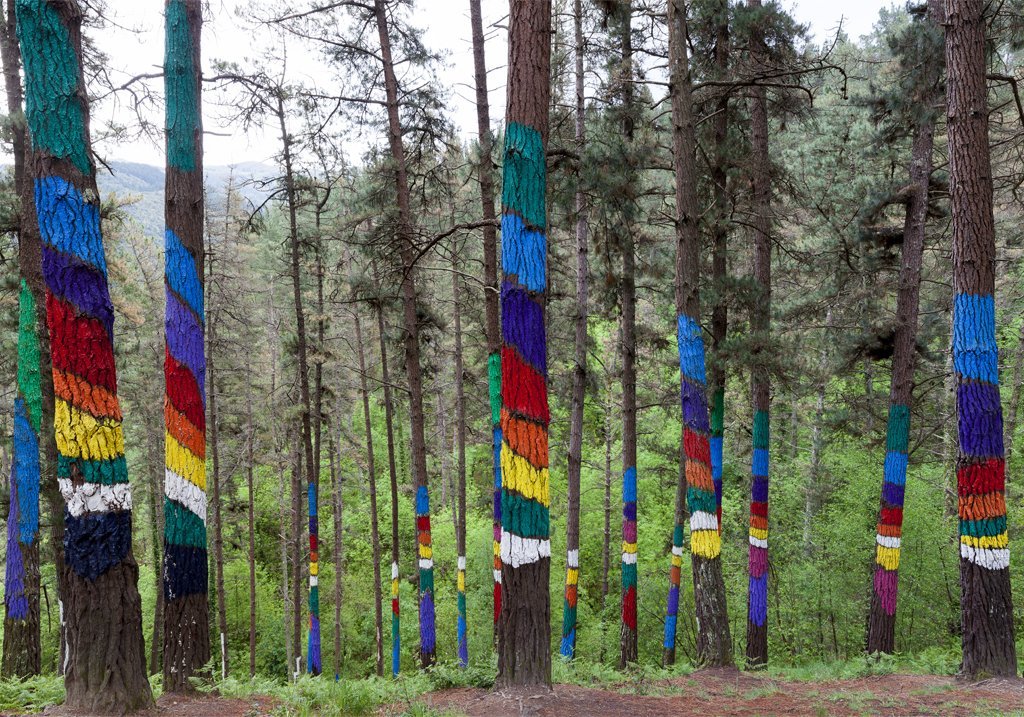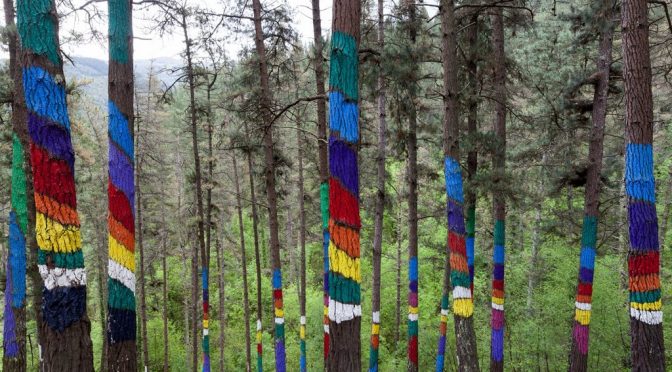Not far from Gernika, in the forests of the small village of Kortezubi, resides one of the most unusual art displays one can imagine. The trees are painted with splashes of color and geometrical forms that, individually, have no rhyme or reason, but together, when viewed from the right spot, form figures and shapes that come to life. The creation of Agustín Ibarrola, the Forest of Oma is but one of his many works that combine nature with human intervention, or take materials of our modern age – things like concrete and railroad ties – to create something new that forces us to look at the world around us in new ways.

- Agustín Ibarrola Goicoechea was born in 1930 in the town of Basauri, Bizkaia. He was born into a working class family, which imparted in him a sense of the struggles of the everyman that he took with him into adulthood. He first studied art in Bilbao and then, thanks to a scholarship, Madrid, where he studied under Daniel Vázquez Díaz and was introduced to cubism. In the 1950s, his friendship with Jorge Oteiza led him to constructivism. In 1956, he moved to Paris and was part of the collection of Spanish artists called “Equipo 57.”
- Ibarrola was a member of the Communist Party and participated in opposition to the Franco regime’s treatment of workers in the 1960s. He was imprisoned twice for his activities, once in 1962 and again in 1967.
- In the 1980s, he began working on one of his most famous “pieces” – the Forest of Oma. He secluded himself in his baserri in Kortezubi and, over the course of 5 years, painted the trees in the forest. Individually, they appear as almost random colors and lines, but when seen from the right vantage point, figures, including animals and humans, appear.
- His work expanded beyond painting and he used many industrial materials in his art. Using railroad ties, for example, he created “Viaje al Infinito,” which resides in the Abando station in Bilbao; “Ola a ritmo de txalaparta” (Chamartín station in Madrid), and “El Bosque de Totems” (Príncipe Pío station in Madrid).
- One of his most recent works involves painting the large concrete blocks that help form the water break in the town of Llanes, just outside of Bilbao in the province of Asturias. The bright cubes – Cubos de la Memoria – contrast with the more stark colors of the ocean and the grey walls that form the rest of the breakwater.
- Ibarrola has been an active member of both the Ermua Forum and ¡Basta Ya!, both of which advocate for the victims of terrorism and against terrorist activities. As a result of his political activities, some of Ibarrola’s works have been attacked and he himself has been threatened, causing him to leave the Basque Country and settle in Ávila.
- His work has garnered multiple awards, including the Medalla de Oro del Círculo de Bellas Artes (1994), la Medalla al Mérito y Reconocimiento al Trabajo (2001), y la Medalla al Orden y Mérito Constitucional (2003).
- In 1977, he painted Guernica Gernikara, part of an attempt to get Picasso’s Guernica to the Basque town of Gernika. The piece, which recreates aspects of Picasso’s work, was long forgotten in Ibarrola’s studio but was recently purchased by the Museum of Fine Arts in Bilbao.
Primary source: Ibarrola Goicoechea, Agustín. Enciclopedia Auñamendi. Available at: https://aunamendi.eusko-ikaskuntza.eus/es/ibarrola-goicoechea-agustin/ar-72311/


